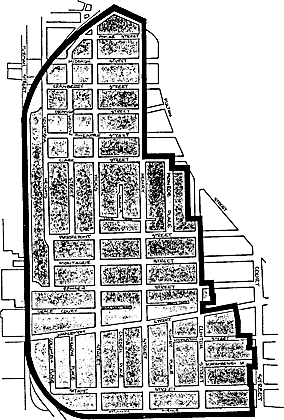 In the late 1940s and early 1950s, Brooklyn Heights residents persuaded “Power Broker” Robert Moses to re-route his plans to ram the BQE through the heart of the neighborhood and to halt bulldozing Willowtown in the name of progress.
In the late 1940s and early 1950s, Brooklyn Heights residents persuaded “Power Broker” Robert Moses to re-route his plans to ram the BQE through the heart of the neighborhood and to halt bulldozing Willowtown in the name of progress.
The woman who led the resistance against Moses on his Willowtown proposal was Mrs. Darwin James, heiress to the Underwood Typewriter fortune and wife of banker Darwin James (who coincidentally gave Moses his start in public service and backed his 1933 run for mayor of NYC). The man who pushed for the creation of our Brooklyn Heights Historic District, Otis Pearsall knew Mrs. James.
He tells the New York Preservation Archive Project, “She was a very interesting and energetic woman, who was tremendously keen on the Heights. And she invested personally; when a lot of houses along Columbia Heights were in jeopardy, she bought those houses just to preserve them, then ultimately sold them off when she found opportunities to put them in strong hands. And she did many things that I could go on about in terms of getting young people, as they began to arrive in Brooklyn Heights, interested in the Heights… She took [my wife] Nancy and me under her wing, along with other people, when we arrived on the Heights, and she had parties at her house at which she tried to have all these young people introduced to one another.”
Pearsall and his wife were part of a new generation of Brooklyn Heights residents — young professionals interested in preserving the neighborhood’s history and beauty. Inspired by Boston’s Beacon Hill Historic District, he proposed what was a radical idea for New York City at the time — instead of landmarking buildings, landmark an entire neighborhood. How he and the Brooklyn Heights Association arrived at the borders we now know was the product of a difficult decision — not to stop the construction of the “new” Cadman Plaza (the BHA did successfully lobby for “larger, family size” apartments to be built on the site). “I made a judgment that we dare not risk this whole new idea and the possibility that we could actually get the preservation of Brooklyn Heights officially in place through a designation. I didn’t want to risk that by dragging in the future of Cadman Plaza.”
The movement for the Brooklyn Heights Historic District began in the fall of 1958 when the Brooklyn Heights Association and Pearsall met at the First Unitarian Church. Later the BHA and another local group who had been protesting the Cadman Plaza project – Community Conservation and Improvement Council (CCIC) – joined forces.
Using New York State’s recently passed Bard Law – which gave cities the authority to save “places, buildings, structures, works of art, and other objects having a special character or special historical or esthetic interest or value” – the group went into action.
They gained support from the community and The Brooklyn Heights Press. Publisher Richard Margolis wrote in an editorial supporting the project, “The community would be free of all the predatory monsters that traditionally devour a neighborhood–the crowded rooming houses, the super block-high income developments, the institutional dormitories.”
In August 1967, after nine years of legal and legislative wrangling, the Brooklyn Heights Historic District was established.
For an excellent in depth account of the process visit the New York Preservation Archive Project



Comments are closed.